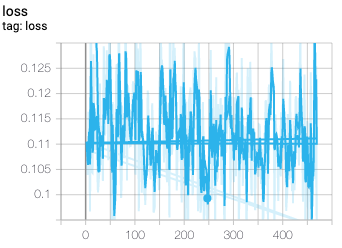Last active
August 17, 2024 08:17
-
-
Save AFAgarap/326af55e36be0529c507f1599f88c06e to your computer and use it in GitHub Desktop.
TensorFlow 2.0 implementation for a vanilla autoencoder. Link to tutorial: https://medium.com/@abien.agarap/implementing-an-autoencoder-in-tensorflow-2-0-5e86126e9f7
This file contains hidden or bidirectional Unicode text that may be interpreted or compiled differently than what appears below. To review, open the file in an editor that reveals hidden Unicode characters.
Learn more about bidirectional Unicode characters
| """TensorFlow 2.0 implementation of vanilla Autoencoder.""" | |
| import numpy as np | |
| import tensorflow as tf | |
| __author__ = "Abien Fred Agarap" | |
| np.random.seed(1) | |
| tf.random.set_seed(1) | |
| batch_size = 128 | |
| epochs = 10 | |
| learning_rate = 1e-2 | |
| intermediate_dim = 64 | |
| original_dim = 784 | |
| (training_features, _), _ = tf.keras.datasets.mnist.load_data() | |
| training_features = training_features / np.max(training_features) | |
| training_features = training_features.reshape(training_features.shape[0], | |
| training_features.shape[1] * training_features.shape[2]) | |
| training_features = training_features.astype('float32') | |
| training_dataset = tf.data.Dataset.from_tensor_slices(training_features) | |
| training_dataset = training_dataset.batch(batch_size) | |
| training_dataset = training_dataset.shuffle(training_features.shape[0]) | |
| training_dataset = training_dataset.prefetch(batch_size * 4) | |
| class Encoder(tf.keras.layers.Layer): | |
| def __init__(self, intermediate_dim): | |
| super(Encoder, self).__init__() | |
| self.hidden_layer = tf.keras.layers.Dense( | |
| units=intermediate_dim, | |
| activation=tf.nn.relu, | |
| kernel_initializer='he_uniform' | |
| ) | |
| self.output_layer = tf.keras.layers.Dense( | |
| units=intermediate_dim, | |
| activation=tf.nn.sigmoid | |
| ) | |
| def call(self, input_features): | |
| activation = self.hidden_layer(input_features) | |
| return self.output_layer(activation) | |
| class Decoder(tf.keras.layers.Layer): | |
| def __init__(self, intermediate_dim, original_dim): | |
| super(Decoder, self).__init__() | |
| self.hidden_layer = tf.keras.layers.Dense( | |
| units=intermediate_dim, | |
| activation=tf.nn.relu, | |
| kernel_initializer='he_uniform' | |
| ) | |
| self.output_layer = tf.keras.layers.Dense( | |
| units=original_dim, | |
| activation=tf.nn.sigmoid | |
| ) | |
| def call(self, code): | |
| activation = self.hidden_layer(code) | |
| return self.output_layer(activation) | |
| class Autoencoder(tf.keras.Model): | |
| def __init__(self, intermediate_dim, original_dim): | |
| super(Autoencoder, self).__init__() | |
| self.encoder = Encoder(intermediate_dim=intermediate_dim) | |
| self.decoder = Decoder( | |
| intermediate_dim=intermediate_dim, | |
| original_dim=original_dim | |
| ) | |
| def call(self, input_features): | |
| code = self.encoder(input_features) | |
| reconstructed = self.decoder(code) | |
| return reconstructed | |
| autoencoder = Autoencoder( | |
| intermediate_dim=intermediate_dim, | |
| original_dim=original_dim | |
| ) | |
| opt = tf.optimizers.Adam(learning_rate=learning_rate) | |
| def loss(model, original): | |
| reconstruction_error = tf.reduce_mean(tf.square(tf.subtract(model(original), original))) | |
| return reconstruction_error | |
| def train(loss, model, opt, original): | |
| with tf.GradientTape() as tape: | |
| gradients = tape.gradient(loss(model, original), model.trainable_variables) | |
| gradient_variables = zip(gradients, model.trainable_variables) | |
| opt.apply_gradients(gradient_variables) | |
| writer = tf.summary.create_file_writer('tmp') | |
| with writer.as_default(): | |
| with tf.summary.record_if(True): | |
| for epoch in range(epochs): | |
| for step, batch_features in enumerate(training_dataset): | |
| train(loss, autoencoder, opt, batch_features) | |
| loss_values = loss(autoencoder, batch_features) | |
| original = tf.reshape(batch_features, (batch_features.shape[0], 28, 28, 1)) | |
| reconstructed = tf.reshape(autoencoder(tf.constant(batch_features)), (batch_features.shape[0], 28, 28, 1)) | |
| tf.summary.scalar('loss', loss_values, step=step) | |
| tf.summary.image('original', original, max_outputs=10, step=step) | |
| tf.summary.image('reconstructed', reconstructed, max_outputs=10, step=step) |
Thanks, @lorenzo-rovigatti. Sorry, I wasn't able to respond sooner. Yes, I also used Adam in my experiment with this autoencoder in TF 2.0.0-beta1.
OK good to know, thanks!
Hi, thanks for sharing this. As you suggested in your Medium article I tried to implement a CNN architecture but something isn't working properly. My restructured images are all black. And this is the loss I get:

The code: click here
Can you help me? What am I doing wrong? Thanks for your appreciated help!
Sign up for free
to join this conversation on GitHub.
Already have an account?
Sign in to comment
Hey, thanks a bunch for this gist. I am quite new to TF (and machine/deep learning in general) and this is the kind of stuff that is really helping me.
However, I cannot seem to make it work. This is the loss function I get (after more than 10 epochs):
It seems to plateau after an initial descent, and the reconstructed pictures all look like this one:
Differently from your tutorial, I am using TF 2.0.0-beta1. Is there anything that has between the alpha and the beta versions and could have broken this gist?
Edit: it looks like using an Adam optimiser rather than the SGD solves this issue.